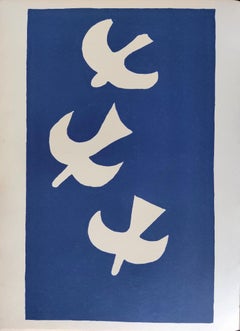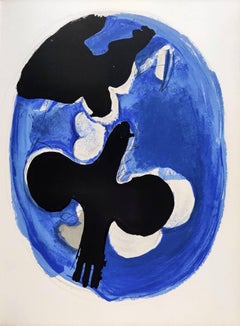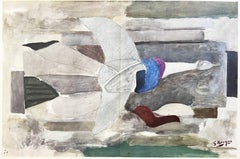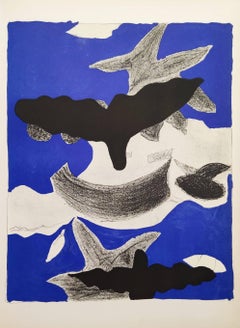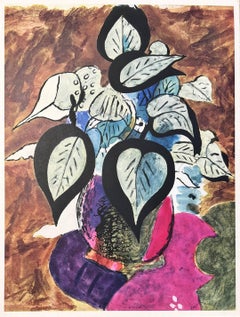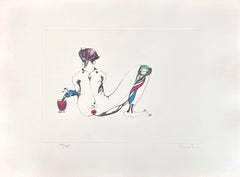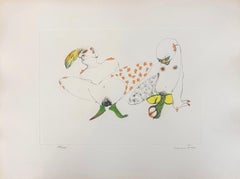George Braque Art
French, 1882-1963
Georges Braque was born on May 13, 1882, in Argenteuil-sur-Seine, France. Braque grew up in the town of Le Havre, and studied evenings at the Ecole des Beaux-Arts there from about 1897 to 1899. Braque left for Paris to study under a master decorator to receive his craftsman certificate in 1901. From 1902 to 1904, Braque painted at the Académie Humbert in Paris, where he met Marie Laurencin and Francis Picabia. By 1906, Braque's work was no longer Impressionist but Fauve in style. After spending the summer of that year in Antwerp with Othon Friesz, he showed his Fauve in the 1907 Salon des Indépendants in Paris. His first solo show was at Daniel-Henri Kahnweiler's gallery in 1908.
From 1909 forward, Braque collaborated with Pablo Picasso in developing Cubism, and by 1911, their styles had become extremely similar. In 1912, they started to incorporate collage elements into their paintings and to experiment with the papier collé (pasted paper) technique. Their collaboration lasted until 1914. Braque served in the French army during World War I and was wounded in battle. Upon recovering, he developed a close friendship with the artist Juan Gris. After World War I, Braque's work became less and less schematic and more free. His fame grew in 1922 as a result of an exhibition at the Salon d'Automne in Paris. In the mid-1920s, Braque designed the decor for two Sergei Diaghilev ballets. By the end of the decade, he had returned to a more realistic interpretation of nature, although Cubist elements always remained present in his work.
In 1931, Braque made his first engraved plasters and began to portray mythological subjects. His first important retrospective took place in 1933 at the Kunsthalle Basel. In 1937 he won First Prize at the Carnegie International in Pittsburgh. During World War II, Braque remained in Paris. His paintings at that time, primarily still lifes and interiors, became more somber. In addition to paintings, Braque also made lithographs, engravings, and sculpture. From the late 1940s, he treated various recurring themes, such as birds, ateliers, landscapes, and seascapes. In 1954, he designed stained-glass windows for the Varengeville Church. During the last few years of his life, Braque's ill health prevented him from undertaking further large-scale commissions, but he continued to paint, print lithographs, and design jewelry. He died on August 31, 1963, in Paris.to
10
1
Overall Width
to
Overall Height
to
11
1
9
1
10
1
11
11
32
198
188
168
39
11
Artist: George Braque
Dealer: Epicentrum Art Gallery
Carnets intimes de Braque II
By George Braque
Located in OPOLE, PL
Georges Braque (1882-1963) - Carnets intimes de Braque II
Lithograph from 1955.
Dimensions of work: 35 x 26 cm
Publisher: Tériade, Paris.
The work is in Excellent condition.
Fas...
Category
1950s Surrealist George Braque Art
Materials
Lithograph
Cubist Portrait
By George Braque
Located in OPOLE, PL
Georges Braque (1882-1963) - Cubist Portrait
Lithograph from 1939.
Dimensions of work: 35 x 26 cm
Publisher: Tériade, Paris.
The work is in Excellent condition.
Fast and secure ...
Category
1930s Surrealist George Braque Art
Materials
Lithograph
Carnets intimes de Braque XIII
By George Braque
Located in OPOLE, PL
Georges Braque (1882-1963) - Carnets intimes de Braque XIII
Lithograph from 1955.
Dimensions of work: 35 x 26 cm
Publisher: Tériade, Paris.
The work is in Excellent condition.
F...
Category
1950s Surrealist George Braque Art
Materials
Lithograph
Carnets intimes de Braque X
By George Braque
Located in OPOLE, PL
Georges Braque (1882-1963) - Carnets intimes de Braque X
Lithograph from 1955.
Dimensions of work: 52 x 35 cm
Publisher: Tériade, Paris.
The work is in Excellent condition.
Fast...
Category
1950s Surrealist George Braque Art
Materials
Lithograph
Carnets intimes de Braque V
By George Braque
Located in OPOLE, PL
Georges Braque (1882-1963) - Carnets intimes de Braque V
Lithograph from 1955.
Dimensions of work: 35 x 26 cm
Publisher: Tériade, Paris.
The work is in Excellent condition.
Fast...
Category
1950s Surrealist George Braque Art
Materials
Lithograph
Carnets intimes de Braque VIII
By George Braque
Located in OPOLE, PL
Georges Braque (1882-1963) - Carnets intimes de Braque VIII
Lithograph from 1955.
Dimensions of work: 35 x 26 cm
Publisher: Tériade, Paris.
The work is in Excellent condition.
F...
Category
1950s Surrealist George Braque Art
Materials
Lithograph
Carnets intimes de Braque XII
By George Braque
Located in OPOLE, PL
"Georges Braque (1882-1963) - Carnets intimes de Braque XII
Lithograph from 1955.
Dimensions of work: 35 x 26 cm
Publisher: Tériade, Paris.
The work is in Excellent condition.
F...
Category
1950s Surrealist George Braque Art
Materials
Lithograph
Carnets intimes de Braque III
By George Braque
Located in OPOLE, PL
Georges Braque (1882-1963) - Carnets intimes de Braque III
Lithograph from 1955.
Dimensions of work: 35 x 26 cm
Publisher: Tériade, Paris.
The work is in Excellent condition.
Fa...
Category
1950s Surrealist George Braque Art
Materials
Lithograph
Colombe sur fond vert
By George Braque
Located in OPOLE, PL
Georges Braque (1882-1963) - Colombe sur fond vert
Lithograph from 1975.
Edition 371/575 (Photocopy of the colophone is included).
Dimensions of work: 31 x 24 cm.
Plate signed.
...
Category
1970s Modern George Braque Art
Materials
Lithograph
Carnets intimes de Braque IX
By George Braque
Located in OPOLE, PL
Georges Braque (1882-1963) - Carnets intimes de Braque IX
Lithograph from 1955.
Dimensions of work: 35 x 26 cm
Publisher: Tériade, Paris.
The work is in Excellent condition.
Fas...
Category
1950s Surrealist George Braque Art
Materials
Lithograph
Le Coq
By George Braque
Located in OPOLE, PL
Georges Braque (1882-1963) - Le Coq
Lithograph from 1952.
Dimensions of work: 35 x 26 cm
Publisher: Tériade, Paris.
The work is in Excellent condition.
Fast and secure shipment.
Category
1950s Surrealist George Braque Art
Materials
Lithograph
Related Items
Pioneer - Hand-signed and numbered lithograph Leonor Fini Surrealist, 1975
By Leonor Fini
Located in New York, NY
Leonor Fini
Pioneer, 1975
Colored etching on Arches paper
11 × 15 in 28 × 38 cm
Limited edition of 185
Category
1970s Surrealist George Braque Art
Materials
Lithograph
Pendant l'été - Hand-signed numbered lithograph Leonor Fini Surrealist, 1975
By Leonor Fini
Located in New York, NY
Leonor Fini
Pendant l'été, 1975
Colored etching on Arches paper
11 × 15 in 28 × 38 cm
Limited edition of 185
Category
1970s Surrealist George Braque Art
Materials
Lithograph
FOREST Hand Drawn Signed Lithograph, Surreal Mini Landscape Misty Trees Blue Sky
By Fanny Brennan
Located in Union City, NJ
FOREST is a rarely seen, hand drawn limited edition lithograph by the American surrealist artist Fanny Brennan, created using traditional hand lithography techniques printed on archi...
Category
1990s Surrealist George Braque Art
Materials
Lithograph
Marc Chagall - The Red Rider - Original Lithograph
By Marc Chagall
Located in Collonge Bellerive, Geneve, CH
Marc Chagall - Original Lithograph
The Red Rider
From the unsigned, unnumbered lithograph printed in the literary review XXe Siecle
1957
See Mourlot 191
Dimensions: 32 x 24 cm
Publisher: G. di San Lazzaro.
Marc Chagall (born in 1887)
Marc Chagall was born in Belarus in 1887 and developed an early interest in art. After studying painting, in 1907 he left Russia for Paris, where he lived in an artist colony on the city’s outskirts. Fusing his own personal, dreamlike imagery with hints of the fauvism and cubism popular in France at the time, Chagall created his most lasting work—including I and the Village (1911)—some of which would be featured in the Salon des Indépendants exhibitions. After returning to Vitebsk for a visit in 1914, the outbreak of WWI trapped Chagall in Russia. He returned to France in 1923 but was forced to flee the country and Nazi persecution during WWII. Finding asylum in the U.S., Chagall became involved in set and costume design before returning to France in 1948. In his later years, he experimented with new art forms and was commissioned to produce numerous large-scale works. Chagall died in St.-Paul-de-Vence in 1985.
The Village
Marc Chagall was born in a small Hassidic community on the outskirts of Vitebsk, Belarus, on July 7, 1887. His father was a fishmonger, and his mother ran a small sundries shop in the village. As a child, Chagall attended the Jewish elementary school, where he studied Hebrew and the Bible, before later attending the Russian public school. He began to learn the fundamentals of drawing during this time, but perhaps more importantly, he absorbed the world around him, storing away the imagery and themes that would feature largely in most of his later work.
At age 19 Chagall enrolled at a private, all-Jewish art school and began his formal education in painting, studying briefly with portrait artist Yehuda Pen. However, he left the school after several months, moving to St. Petersburg in 1907 to study at the Imperial Society for the Protection of Fine Arts. The following year, he enrolled at the Svanseva School, studying with set designer Léon Bakst, whose work had been featured in Sergei Diaghilev's Ballets Russes. This early experience would prove important to Chagall’s later career as well.
Despite this formal instruction, and the widespread popularity of realism in Russia at the time, Chagall was already establishing his own personal style, which featured a more dreamlike unreality and the people, places and imagery that were close to his heart. Some examples from this period are his Window Vitebsk (1908) and My Fianceé with Black Gloves (1909), which pictured Bella Rosenfeld, to whom he had recently become engaged.
The Beehive
Despite his romance with Bella, in 1911 an allowance from Russian parliament member and art patron Maxim Binaver enabled Chagall to move to Paris, France. After settling briefly in the Montparnasse neighborhood, Chagall moved further afield to an artist colony known as La Ruche (“The Beehive”), where he began to work side by side with abstract painters such as Amedeo Modigliani and Fernand Léger as well as the avant-garde poet Guillaume Apollinaire. At their urging, and under the influence of the wildly popular fauvism and cubism, Chagall lightened his palette and pushed his style ever further from reality. I and the Village (1911) and Homage to Apollinaire (1912) are among his early Parisian works, widely considered to be his most successful and representative period.
Though his work stood stylistically apart from his cubist contemporaries, from 1912 to 1914 Chagall exhibited several paintings at the annual Salon des Indépendants exhibition, where works by the likes of Juan Gris, Marcel Duchamp and Robert Delaunay were causing a stir in the Paris art world. Chagall’s popularity began to spread beyond La Ruche, and in May 1914 he traveled to Berlin to help organize his first solo exhibition, at Der Sturm Gallery. Chagall remained in the city until the highly acclaimed show opened that June. He then returned to Vitebsk, unaware of the fateful events to come.
War, Peace and Revolution
In August 1914 the outbreak of World War I precluded Chagall’s plans to return to Paris. The conflict did little to stem the flow of his creative output, however, instead merely giving him direct access to the childhood scenes so essential to his work, as seen in paintings such as Jew in Green (1914) and Over Vitebsk (1914). His paintings from this period also occasionally featured images of the war’s impact on the region, as with Wounded Soldier (1914) and Marching (1915). But despite the hardships of life during wartime, this would also prove to be a joyful period for Chagall. In July 1915 he married Bella, and she gave birth to a daughter, Ida, the following year. Their appearance in works such as Birthday (1915), Bella and Ida by the Window (1917) and several of his “Lovers” paintings give a glimpse of the island of domestic bliss that was Chagall’s amidst the chaos.
To avoid military service and stay with his new family, Chagall took a position as a clerk in the Ministry of War Economy in St. Petersburg. While there he began work on his autobiography and also immersed himself in the local art scene, befriending novelist Boris Pasternak, among others. He also exhibited his work in the city and soon gained considerable recognition. That notoriety would prove important in the aftermath of the 1917 Russian Revolution when he was appointed as the Commissar of Fine Arts in Vitebsk. In his new post, Chagall undertook various projects in the region, including the 1919 founding of the Academy of the Arts. Despite these endeavors, differences among his colleagues eventually disillusioned Chagall. In 1920 he relinquished his position and moved his family to Moscow, the post-revolution capital of Russia.
In Moscow, Chagall was soon commissioned to create sets and costumes for various productions at the Moscow State Yiddish Theater, where he would paint a series of murals titled Introduction to the Jewish Theater as well. In 1921, Chagall also found work as a teacher at a school for war orphans. By 1922, however, Chagall found that his art had fallen out of favor, and seeking new horizons he left Russia for good.
Flight
After a brief stay in Berlin, where he unsuccessfully sought to recover the work exhibited at Der Sturm before the war, Chagall moved his family to Paris in September 1923. Shortly after their arrival, he was commissioned by art dealer and publisher Ambroise Vollard to produce a series of etchings for a new edition of Nikolai Gogol's 1842 novel Dead Souls. Two years later Chagall began work on an illustrated edition of Jean de la Fontaine’s Fables, and in 1930 he created etchings for an illustrated edition of the Old Testament, for which he traveled to Palestine to conduct research.
Chagall’s work during this period brought him new success as an artist and enabled him to travel throughout Europe in the 1930s. He also published his autobiography, My Life (1931), and in 1933 received a retrospective at the Kunsthalle in Basel, Switzerland. But at the same time that Chagall’s popularity was spreading, so, too, was the threat of Fascism and Nazism. Singled out during the cultural "cleansing" undertaken by the Nazis in Germany, Chagall’s work was ordered removed from museums throughout the country. Several pieces were subsequently burned, and others were featured in a 1937 exhibition of “degenerate art” held in Munich. Chagall’s angst regarding these troubling events and the persecution of Jews in general can be seen in his 1938 painting White Crucifixion.
With the eruption of World War II, Chagall and his family moved to the Loire region before moving farther south to Marseilles following the invasion of France. They found a more certain refuge when, in 1941, Chagall’s name was added by the director of the Museum of Modern Art (MOMA) in New York City to a list of artists and intellectuals deemed most at risk from the Nazis’ anti-Jewish campaign. Chagall and his family would be among the more than 2,000 who received visas and escaped this way.
Haunted Harbors
Arriving in New York City in June 1941, Chagall discovered that he was already a well-known artist there and, despite a language barrier, soon became a part of the exiled European artist community. The following year he was commissioned by choreographer Léonide Massine to design sets and costumes for the ballet Aleko, based on Alexander Pushkin’s “The Gypsies” and set to the music of Pyotr Ilyich Tchaikovsky.
But even as he settled into the safety of his temporary home, Chagall’s thoughts were frequently consumed by the fate befalling the Jews of Europe and the destruction of Russia, as paintings such as The Yellow Crucifixion...
Category
1950s Surrealist George Braque Art
Materials
Lithograph
De l'Origine des Espèces par Voie de Sélection Irrationelle: Visage
By Man Ray
Located in New York, NY
A very good impression of this color lithograph. Artist's proof, aside from the edition of 180. Signed and inscribed "EA" in pencil. Printed by Mourlot, Paris. Published by Leon Amie...
Category
1970s Surrealist George Braque Art
Materials
Color, Lithograph
TAGGED TREE Signed Lithograph, Mini Landscape, Tree, Water, Sky, Surrealism
By Fanny Brennan
Located in Union City, NJ
TAGGED TREE is a rarely seen, hand drawn limited edition lithograph by the American surrealist artist Fanny Brennan, created using traditional hand lithography techniques printed on ...
Category
1990s Surrealist George Braque Art
Materials
Lithograph
Autumn afternoons - Hand-signed numbered lithograph Leonor Fini Surrealist, 1975
By Leonor Fini
Located in New York, NY
Leonor Fini
Pendant les après-midi d'automne, 1975
Colored etching on Arches paper
11 × 15 in 28 × 38 cm
Limited edition of 185
Condition: Excellent condition
Category
1970s Surrealist George Braque Art
Materials
Lithograph
Ma fortune - Hand-signed numbered lithograph by Leonor Fini, Surrealist, 1975
By Leonor Fini
Located in New York, NY
Leonor Fini
Ma fortune, 1975
Colored etching on Arches paper
11 × 15 in 28 × 38 cm
Limited edition of 185
Condition: Excellent condition
Category
1970s Surrealist George Braque Art
Materials
Lithograph
Du fil à retordre - Hand-signed numbered lithograph Leonor Fini Surrealist, 1975
By Leonor Fini
Located in New York, NY
Leonor Fini
Du fil à retordre, 1975
Colored etching on Arches paper
11 × 15 in 28 × 38 cm
Limited edition of 185
Condition: Excellent condition
Category
1970s Surrealist George Braque Art
Materials
Lithograph
Poema visual
By Joan Brossa
Located in New York, NY
Lithograph on paper (Edition of 25)
Signed in pencil, l.r.
Numbered in pencil, l.l.
This print is offered by ClampArt, located in New York City.
Joan Brossa (1919-1998) was a Cata...
Category
1980s Post-Minimalist George Braque Art
Materials
Lithograph
Wealth Health Fame and Love
By Salvador Dalí
Located in Hollywood, FL
ARTIST: Salvador Dali
TITLE: Wealth Health Fame and Love
MEDIUM: Lithograph on Japon Paper
SIGNED: Hand Signed
PUBLISHER: Levine & Levine for Collectors Guild/Center Art
EDITIO...
Category
1970s Surrealist George Braque Art
Materials
Lithograph
Damien Hirst Signed Lithograph "The Currency" Contemporary Modern Street Art
By Damien Hirst
Located in Draper, UT
These hand signed lithograph prints were only made available to "HOLDERS" of the Currency prints. Less than 1000 were hand signed by Damien Hirst a...
Category
2010s Contemporary George Braque Art
Materials
Lithograph
George Braque art for sale on 1stDibs.
Find a wide variety of authentic George Braque art available for sale on 1stDibs. You can also browse by medium to find art by George Braque in lithograph, etching, aquatint and more. Much of the original work by this artist or collective was created during the 20th century and is mostly associated with the abstract style. Not every interior allows for large George Braque art, so small editions measuring 10 inches across are available. Customers who are interested in this artist might also find the work of Olivier Attar, Max Papart, and Alfred MANESSIER. George Braque art prices can differ depending upon medium, time period and other attributes. On 1stDibs, the price for these items starts at $500 and tops out at $9,000, while the average work can sell for $3,713.
Artists Similar to George Braque
Questions About George Braque Art
- 1stDibs ExpertApril 5, 2022Georges Braque is known for being one of the leading artists in both the Fauve and Cubist art movements of the early 20th century. The French artist produced paintings, collages, prints and sculptures. On 1stDibs, find a variety of Georges Braque art.
- Was Georges Braque a Surrealist?1 Answer1stDibs ExpertAugust 29, 2024No, Georges Braque was not a Surrealist. Influenced by Henri Matisse, Braque's early works display the bright colors and emotional symbolism common to Fauvist art. Later in his career, the French artist worked primarily in Cubism alongside his contemporary Pablo Picasso. Shop a selection of Georges Braque art on 1stDibs.
